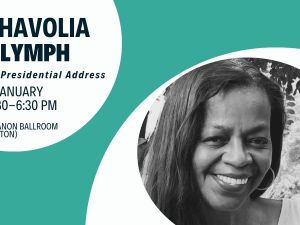From Warm Welcome to the Desire to Expel: New Book from Historian Cecilia Márquez Examines the Racialization of Latinos in the U.S. South
Para leer este artículo en español, haga clic aquí.
“In a lot of ways this is a weird story, and sort of unexpected,” says Cecilia Márquez, Hunt Family Assistant Professor of History, about her new book, “Making the Latino South: A History of Racial Formation.”
The book's trajectory examines the racialization of non-Black Latinos in the U.S. South from the 1940s to the early 2000s. Márquez explores big questions like “How is race made?” and “How do we make meaning from race?” through chapters organized as case studies, or what she calls “moments of encounter” — narratives that engage the reader while illuminating the historical context of the time.
The book begins in the era directly before the civil rights movement, a period saturated with questions about the future of race in the South. “I’m interested in knowing how Latinos fit into that question,” she said.
Márquez tackles this question with a roadmap explaining the large-scale migration of Latinos to the region, while also examining how Latinos as a group — one that holds a huge amount of diversity — has evolved racially in the second half of the 20th century.
What she finds is that Latinos in the South in the 1940s were separated roughly into Black and non-Black Latinos, the latter often coexisting in white communities, which she notes as surprising to a lot of people.
“People think of the South as this place that is deeply segregated and racist — and those things are true — but non-Black Latinos somehow found a way to make space for themselves in the Jim Crow order, under the umbrella of whiteness,” Márquez said.
Simply put, those Latinos who were not Black had access to whiteness.
“In some ways, Latinos in the South in the 1940s were similar to what someone might expect of Italians or Irish at the time,” she explained. “But why is it that the Irish and Italians become white, and Latinos don’t?”
The initial proximity to whiteness for non-Black Latinos had very material consequences, from access to education to the cost of a home. Márquez argues that it was possible, in part, because of the South’s structure and organization around Blackness and policing the boundaries of Blackness.
“I think one of my big contributions is thinking about how Latino identity is formed in relation to Blackness,” she said. “One of the ways that I do that is by looking at the different experiences of Black and non-Black Latinos.”
For example, in one chapter, Márquez explores Latino involvement in the Student Nonviolent Coordinating Committee (SNCC), the youth vanguard of the Southern civil rights movement.
“I think that, too often, the story of Latino history is told in isolation. I'm suggesting that in order to understand Latino as a category, we have to understand how anti-Blackness shapes the boundaries of Latinos,” she said.
Another section of the book is devoted to the impact of industry on migration by looking at carpet manufacturing plants in Dalton, Georgia in the 1980s. Márquez argues that this is a time and place where Latinos arriving in the South first become a racial group, categorized as “hardworking Hispanics.”
“In the 90s, there's this idea that Latinos are hyper-productive, family-oriented, religious, ‘good people’ who are saving many Southern industries,” she said. “That’s sort of the first moment of racialization, which I suggest is complicated because part of it is naturalizing the exploitation of Latinos.”
Márquez notes how even ‘hardworking Hispanic’ as a category is still defining itself in relation to the US-born Black population. “It was the late 80s and early 90s, on the heels of Reaganomics and the myth of the ‘Welfare Queen’ — so it has a ring of anti-Blackness,” she said.
In another chapter, “Pedro Goes to Confederateland: Playing Mexican at South of the Border, 1945–1965,” Márquez explores ideas about Latinos through the lens of a Mexican-themed rest stop and amusement park on the North and South Carolina state line, home to a 100-foot statue of Pedro, a caricature created by the park’s founder.
“One of the things that white people did when they visited South of the Border in the 1960s was dress up as Pedro — sombreros, serapes, the whole thing,” she explained. “I’m interested in how Mexicanness is a space where white people — in a moment when they’re starting to see wins of the civil rights movement — still safely play with ideas about race, because in 1961, the owner opens Confederateland on the same property, and Pedro is part of it.”
Confederateland? “Yes. It’s exactly what you think it is,” she said.
Márquez concludes with a chapter titled “The Aliens Are Here,” about how the combination of 9/11 and the 2008 global financial crisis result in a national panic and rise in xenophobia that turns the South from a welcoming place for Latinos to a hostile one, transforming the “hardworking Hispanic” into the “illegal alien.”
When asked who she sees as the audience for her book, Márquez notes the obvious historians and educators, but also says the book is for young, Latino people in the South today who are learning a Southern history that doesn’t include their experiences.
“Young people deserve to learn all parts of their history,” she said. “The South has changed so much in the past 30 years, and Latinos have their own Southern legacies that need to be both celebrated and reckoned with. My hope is that the stories like those in the book can help us answer the question: What is the Latino history of the South?"






